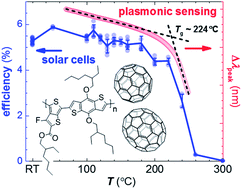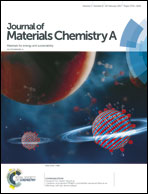A fullerene alloy based photovoltaic blend with a glass transition temperature above 200 °C†
Abstract
Organic solar cells with a high degree of thermal stability require bulk-heterojunction blends that feature a high glass transition, which must occur considerably above the temperatures encountered during device fabrication and operation. Here, we demonstrate for the first time a polymer : fullerene blend with a glass transition temperature above 200 °C, which we determine by plasmonic nanospectroscopy. We achieve this strong tendency for glass formation through the use of an alloy of neat, unsubstituted C60 and C70, which we combine with the fluorothieno-benzodithiophene copolymer PTB7. A stable photovoltaic performance of PTB7 : C60 : C70 ternary blends is preserved despite annealing the active layer at up to 180 °C, which coincides with the onset of the glass transition. Rapid deterioration of the power conversion efficiency from initially above 5% only occurs upon exceeding the glass transition temperature of 224 °C of the ternary blend.



 Please wait while we load your content...
Please wait while we load your content...